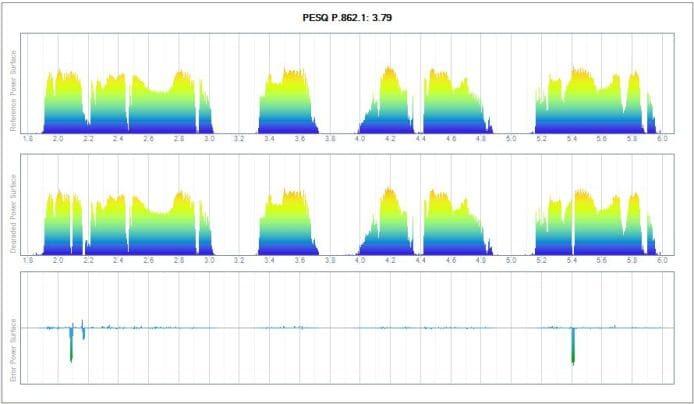The tool described in ITU-T Rec. P.862 Perceptual Evaluation of Speech Quality - PESQ provides a rapid and repeatable measure of speech quality in a few moments.
The tool is integrated into our MultiDSLA system. You can use it to test analog, digital and VoIP systems using our high quality interfaces, as well as running PESQ over your own speech recordings using the File Processor option also included in MultiDSLA.

Unique insight into speech quality issues identified by PESQ
We are proud of how our product gives engineers a unique insight into speech quality issues identified by PESQ. We have helped many engineers extract more value from their speech quality testing and PESQ analysis.
Contact us now to find out how we might help you see more value from your testing, or continue reading to learn about the history of PESQ and about the types of application for which it is suitable.
PESQ : Objective measurement tool
PESQ is an objective measurement tool that predicts the results of subjective listening tests on telephony systems.
PESQ uses a sensory model to compare the original, unprocessed signal with the degraded signal from the network or network element. The resulting quality score is analogous to the subjective "Mean Opinion Score" (MOS) measured using panel tests according to ITU-T P.800. The PESQ scores are calibrated using a large database of subjective tests.
The ITU-T selection process that resulted in the standardisation of PESQ involved a wide range of conditions, with demanding correlation requirements set to ensure that it has good performance in assessing conventional fixed and mobile networks and packet-based transmission systems.
Since ITU-T Rec. P.862 was released three further mappings of the PESQ score have been created. PESQ-LQ modified the score to improve correlation with subjective test results at the high and low ends of the scale where the raw PESQ score was found to be less accurate. A new mapping described in ITU-T Rec. P.862.1 has been released that further modifies the raw score and is believed to better correlate to subjective test. A wideband mapping, P.862.2 improves correlation to wideband subjective test results. All these mappings are determined and displayed in MultiDSLA, DSLA and SPA measurements.
PESQ takes into account coding distortions, errors, packet loss, delay and variable delay, and filtering in analogue network components. The user interfaces have been designed to provide a simple access to this powerful algorithm, either directly from the analogue connection or from speech files recorded elsewhere.
The performance of a network or a network element can be fully characterised using the Digital Speech Level Analyser and PESQ. Whilst it is possible to use phonetically balanced sentences and other test patterns, accurate and repeatable measurements of the active speech level, activity, delay, echo, noise and speech quality can be obtained quickly using the artificial speech test stimulus in different languages. A graphical mapping of the errors provides a useful insight into how the signal has been degraded.
This powerful test tool can be deployed in many different areas of a business, on any speech carrier technology:
- In the research laboratory; providing rapid feedback on promising areas of signal processing development, validation of design implementation, ranking alternative design solutions, providing a higher degree of confidence before submission to subjective testing
- In network equipment evaluation; comparing different vendor offerings and determining their impact on network performance
- In network installation and rollout of new technologies; ensuring that the desired speech quality is being delivered as the network complexity and loading increases
- In troubleshooting network and customer problems; determining the scale of the problem, the effectiveness of the solution
- In sales and marketing; demonstrating the excellence of a new product, assuring the customer of the system performance
Since the launch of PESQ in 2000, there have been many advances in codec design. Unfortunately, PESQ was not trained on these later designs and can produce scores that are lower than expected from subjective tests. Time-warping and voice quality enhancement techniques are particularly difficult for PESQ. The ITU agreed on a new standard, P.863 POLQA, in 2010. Now available on Malden’s platforms, POLQA addresses many of the issues and produces reliable scores for codecs, both old and new.
Malden is committed to the development of cost effective tools to measure all aspects of speech transmission performance. The integration of Perceptual Evaluation of Speech Quality and now Perceptual Objective Listening Quality Assessment into the MultiDSLA continues the advances in our measurement technology.
Malden is now Opale Systems, and the team is continuing to develop.
Contact Opale Systems or your distributor for more information.